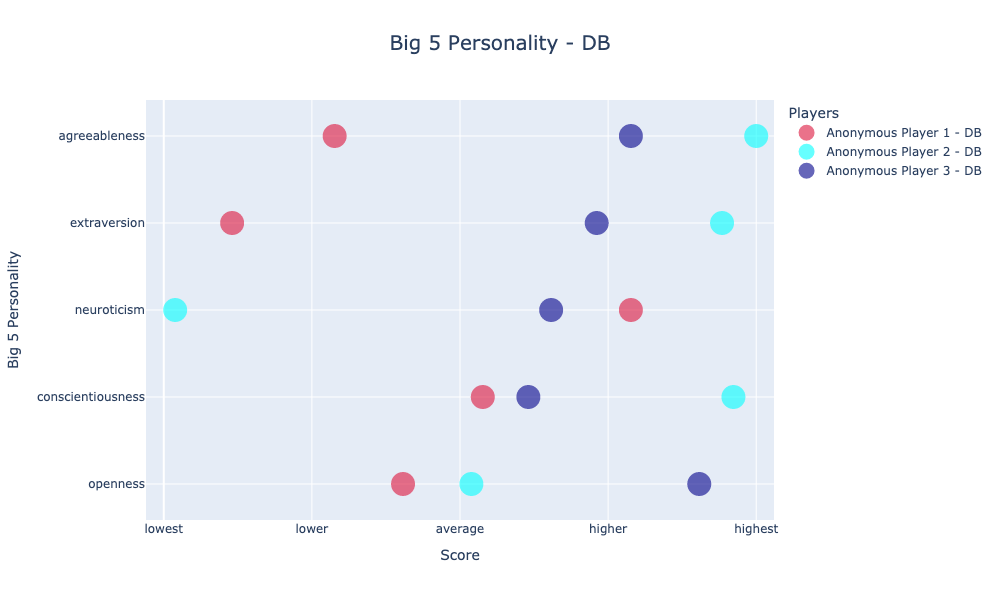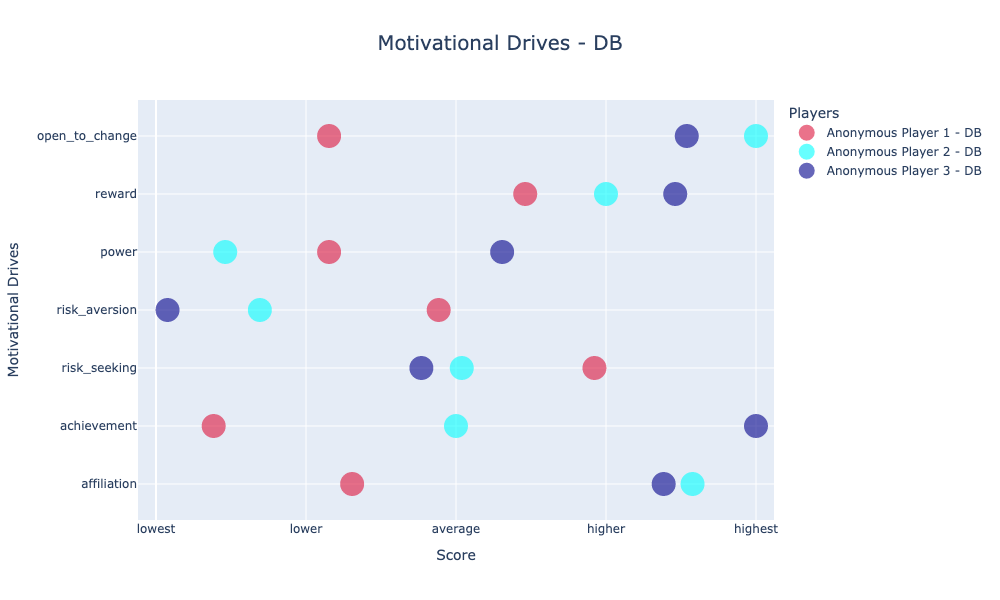Senior Bowl Position Group Psychology Report: Defensive Back
This report was powered by Receptiviti's world-renowned social psychology and language analytics technology and presented by the Tatnuck Group.
The findings contained in this report are based on analysis of each player’s interview with Senior Bowl staff. Scores contained in this report compare athletes to a group of their peers who were also interviewed prior to the Senior Bowl. This contained approach to comparison allows for a precise understanding of athlete similarities and differences.
Insights are meant to provide information for teams and NFL recruiters to consider in their due diligence and preparation for follow-on conversations.
Big 5 Personality

Commonalities Between Defensive Back 1, Defensive Back 2, and Defensive Back 3 - Big 5
Defensive Back 1, Defensive Back 2, and Defensive Back 3 share a relative openness compared to their Senior Bowl peers, with all players scoring at least average or higher. This indicates they are likely to embrace new strategies, adapt to coaching, and experiment with novel approaches to their roles as defensive backs. Additionally, both Defensive Back 1 and Defensive Back 3 show higher levels of neuroticism, reflecting some vulnerability to stress or emotional fluctuations, which may affect their performance in high-pressure moments. These shared traits suggest they are adaptable and open to growth but may benefit from mental conditioning to manage emotional responses effectively during critical situations.
Defensive Back 1's Unique Traits and Implications - Big 5
Defensive Back 1 exhibits one of the lowest extraversion scores among the group, indicating a more reserved and introspective demeanor compared to his peers. His average conscientiousness suggests reliability and discipline, though not at the level of Defensive Back 2 or Defensive Back 3. Combined with higher neuroticism and lower agreeableness, Defensive Back 1's may approach his role with a focus on individual performance rather than fostering collaboration or social harmony. While his introspective style can help him stay focused, his emotional tendencies may require mental resilience training to perform consistently under stress. Developing stronger interpersonal relationships with teammates could further enhance his effectiveness as a communicator in the secondary.
Defensive Back 2's Unique Traits and Implications - Big 5
Defensive Back 2 stands out with the one of the highest extraversion and conscientiousness scores, suggesting he is an outgoing and highly disciplined player. His very low levels of neuroticism highlight emotional stability, making him well-suited for handling high-pressure situations. As one of the players highest on agreeableness, his disposition reflects a cooperative and team-oriented mindset, which is critical for building trust and cohesion in the defensive unit. These traits make Defensive Back 2 a natural leader and motivator on the field. To maximize his impact, he could focus on channeling his energy into maintaining consistent performance across all game scenarios, leveraging his strong interpersonal skills to unify and inspire his teammates.
Defensive Back 3's Unique Traits and Implications - Big 5
Defensive Back 3 combines higher extraversion and very high openness with higher conscientiousness, reflecting a dynamic and innovative approach to his position. His higher neuroticism and agreeableness indicate a balance between emotional sensitivity and a strong commitment to team harmony. While Defensive Back 3’s openness and conscientiousness suggest adaptability and discipline, his neurotic tendencies could affect his ability to stay composed during pivotal moments. To optimize his performance, Defensive Back 3 could benefit from targeted mental conditioning to build emotional resilience and ensure consistency in his play. His collaborative nature and willingness to adapt make him a valuable asset in a versatile defensive scheme.
Interpersonal Style
Commonalities Between Defensive Back 1, Defensive Back 2, and Defensive Back 3 - Interpersonal Style
Defensive Back 1, Defensive Back 2, and Defensive Back 3 share average to high levels of communal traits relative to their Senior Bowl peers, indicating a tendency to prioritize collaborating with teammates to achieve group goals and fostering group cohesion. Additionally, both Defensive Back 2 and Defensive Back 3 demonstrate very highly agentic traits, reflecting assertiveness and a focus on pursuing individual goals. This combination of communal and agentic traits highlights their ability to balance personal performance with team-oriented goals, making them effective contributors to a cohesive defensive unit.
Defensive Back 1's Unique Traits and Implications - Interpersonal Style
Defensive Back 1 demonstrates average agentic traits and higher communal traits, suggesting a balanced interpersonal style with a slight emphasis on teamwork and collaboration. His communal tendencies may help him build strong relationships with teammates, fostering trust and cohesion in the secondary. However, his more moderate agentic traits could limit his willingness to take charge in critical moments, which may be necessary for making impactful plays. To maximize his effectiveness, Defensive Back 1 could focus on enhancing his assertiveness, allowing him to step into a leadership role when required while maintaining his strong sense of teamwork.
Defensive Back 2's Unique Traits and Implications - Interpersonal Style
Defensive Back 2 stands out with a very high level of agentic and a high level of communal traits, indicating a strong focus on both personal achievement and team cohesion. This profile suggests that Defensive Back 2 is a natural leader who can assert his influence while still fostering positive relationships within the group. His ability to balance these dimensions makes him a dynamic player capable of taking initiative while supporting the overall defensive strategy. To further enhance his impact, Defensive Back 2 could ensure that his assertiveness remains aligned with team goals, avoiding the risk of overemphasizing personal objectives in high-pressure situations.
Defensive Back 3's Unique Traits and Implications - Interpersonal Style
Defensive Back 3 also demonstrates a very high degree of agency but pairs this with average communal traits, creating a profile that leans more heavily toward self-focus goals. While his agentic tendencies suggest confidence and decisiveness, his relatively lower communal traits compared to Defensive Back 2 and Defensive Back 1 may limit his ability to build strong interpersonal bonds with teammates. This could hinder communication and collaboration in a defensive backfield that relies on trust and coordination. To optimize his performance, Defensive Back 3 could work on enhancing his communal tendencies, ensuring that his assertiveness complements team dynamics and contributes to a unified defensive effort.
Thinking Style
Commonalities Between Defensive Back 1, Defensive Back 2, and Defensive Back 3 - Thinking Style
Defensive Back 1 and Defensive Back 2 share a higher level of deliberative thinking relative to their Senior Bowl peers. This suggests both players tend to approach decisions with careful consideration and strategic planning, a valuable trait for defensive backs tasked with reading offensive schemes and making adjustments on the field.
Defensive Back 1's Unique Traits and Implications - Thinking Style
Defensive Back 1's higher deliberative thinking level highlights his ability to carefully evaluate situations and make calculated decisions on the field. This trait is particularly advantageous in a defensive backfield, where recognizing patterns and anticipating offensive plays can give him a strategic edge. However, overreliance on slow thinking could hinder his ability to react quickly in dynamic situations, such as responding to a sudden route change or improvisation by an opposing quarterback. To enhance his performance, Defensive Back 1 could focus on developing his intuitive thinking to complement his deliberative style, enabling quicker reactions without compromising his decision-making quality.
Defensive Back 2's Unique Traits and Implications - Thinking Style
Defensive Back 2 also demonstrates a higher degree of deliberative thinking, suggesting a disciplined and thoughtful approach to his role. This deliberation is likely a strength in high-pressure scenarios, such as analyzing the quarterback's reads or making split-second adjustments in coverage. However, like Defensive Back 1, Defensive Back 2 may face challenges in situations requiring rapid, instinctive reactions. To address this, incorporating drills that simulate high-speed, unpredictable scenarios could help Defensive Back 2 refine his instinctive responses while maintaining the strategic depth of his deliberative thinking.
Defensive Back 3's Unique Traits and Implications - Thinking Style
Defensive Back 3 exhibits a lower level of deliberative thinking compared to his peers, indicating a stronger reliance on intuitive, fast-thinking processes. This style enables him to react swiftly to dynamic game situations, such as sudden changes in an opponent's strategy or improvisational plays. However, this reliance on intuition could lead to occasional errors in judgment, particularly in complex scenarios requiring deeper analysis or foresight. To optimize his performance, Defensive Back 3 could work on enhancing his deliberative thinking, allowing him to better anticipate and prepare for nuanced offensive tactics. This balance between fast and slow thinking could make him a more versatile and dependable defensive back.
Motivations

Commonalities Between Defensive Back 1, Defensive Back 2, and Defensive Back 3 - Motivations
Defensive Back 2 and Defensive Back 3 share very high affiliation drives compared to their Senior Bowl peers, indicating a strong desire to connect with teammates and contribute to team cohesion. Additionally, all three players exhibit an above average drive for reward, suggesting they are motivated by tangible outcomes and recognition for their efforts on the field.
Defensive Back 1's Unique Traits and Implications - Motivations
Defensive Back 1 exhibits a lower affiliation drive and one of the lowest achievement drives relative to his Senior Bowl peers, indicating he may be less focused on building social connections or striving for personal milestones compared to his peers. However, his above average reward drive suggests he is motivated by the recognition of his contributions, which could enhance his competitive edge. His average risk aversion and higher risk seeking indicates a balanced approach to taking risks, while his lower openness to change could make him less adaptable to new strategies. To optimize his performance, Defensive Back 1 may benefit from fostering a more team-oriented mindset and embracing innovative approaches, which could enhance his ability to adapt to evolving game dynamics.
Defensive Back 2's Unique Traits and Implications - Motivations
Defensive Back 2 stands out with a very high affiliation drive, indicating a strong focus on building relationships and fostering team unity. His average achievement and higher reward drives highlight a balanced motivation for both personal success and recognition. Additionally, Defensive Back 2's very low risk aversion and average risk seeking suggests a willingness to take calculated risks, which can be a valuable asset in defensive play. His very high openness to change reflects a high degree of adaptability, enabling him to thrive in dynamic and unpredictable game situations. To maximize his impact, Defensive Back 2 could focus on leveraging his strong interpersonal skills and adaptability to lead his teammates effectively while maintaining a calculated approach to risk-taking.
Defensive Back 3's Unique Traits and Implications - Motivations
Defensive Back 3 demonstrates the highest achievement and reward drives compared to Defensive Back 2 and Defensive Back 1, indicating a strong internal motivation to excel and seek tangible outcomes. His very high affiliation drive highlights his focus on fostering team connections, making him a valuable team-oriented player. With average risk-seeking tendencies and very low risk aversion, Defensive Back 3 strikes a balance between cautious and aggressive play. Additionally, his very high openness to change suggests a willingness to adapt to new strategies and roles. To further elevate his performance, Defensive Back 3 could focus on channeling his strong motivation for achievement into consistent efforts while ensuring his risk-taking remains calculated and aligned with team objectives.

"We've always looked for the most effective and reliable means to objectify what we do from an interview and assessment standpoint…Receptiviti did a great job of delivering on that"
- AJ Scola, former Assistant Director/Personnel at the Atlanta Braves and Founder of the Tatnuck Group
A few curated frequently asked questions from recruiters, psychologists, HR professionals, due diligence experts, assessment providers, and sports platforms who already use Receptiviti.
Will Receptiviti write my reports for me?
No, that's the best part. Receptiviti is not a gen-AI engine that produces robotic marketing copy that can handcuff your SEO efforts.
The insights produced by analyzing language data give recruiters, agents, player personnel departments, and head offices more information, allowing them to craft better messages, all based on scientific frameworks designed to help understand audience personality, behaviour, motivation, and more.
For those looking for a way to automate report creation, email us at sales@receptiviti.com to learn more about integrating the Receptiviti API with large language models.
I can't process interview data, how useful is this for me?
The Receptiviti API doesn't store data and all requests are encrypted. No human at Receptiviti can ever read the language data you submit.
Additionally, Receptiviti doesn't have to be used on interview transcripts alone. Social media posts, written tasks, emails, and other consensual sources provide a great source of language data.
For users with very high bandwidth demands or elevated security requirements, we also offer a containerized version of the API that can be installed within any technology environment.
I already have mountains of data, how is this any different?
Receptiviti adds a new layer to your existing data by revealing psychological traits from the language your candidates use.
This goes beyond traditional metrics by helping you understand the motivations and behaviors that drive and shape a candidate's performance and fit.
It's about leveraging insights you can not find anywhere else to unlock new, actionable data that helps you hire more effectively.
I'm not a scientist, how will I be able to understand what all of the data means?
Receptiviti is highly customizable. You or your team will be able to create charts, graphs, and models that work to suit your needs and make sense of the data.
Additionally, many of the insights provided can be mapped to scientifically validated and popular frameworks, such as the Big 5 Personality model, making them more accessible and easy to action.
Is there a trial I can access to see if the API is a fit for me?
Of course. You can request a trial account here.
Do you have any examples of this technology in use?
Absolutely. We have dozens of examples of how psychologists, cognitive scientists, and researchers of all types use the Receptiviti API to uncover personality insights from language data in our blog.
We also welcome you to check out a few specific case studies:
.png)